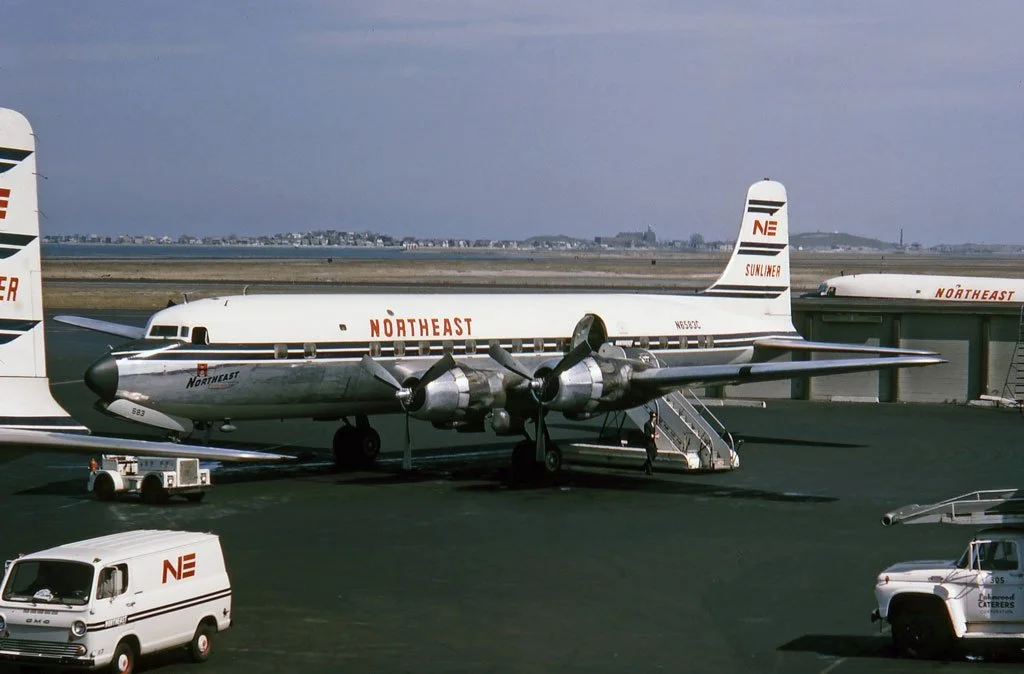Now it’s cattle cars at 35,000 feet
Northeast Airlines DC-6B at Logan International Airport, Boston, in 1966. The Boston-based airline started up in 1931 as Boston-Maine Airways and lasted until it was merged into Delta Air Lines, in 1972.
Adapted from Robert Whitcomb’s “Digital Diary,’’ in GoLocal24.com
I have to fly soon to Florida to give a talk on “working waterfronts” and am dreading it. It’s not because I fear getting COVID inside a plane, or, more likely, while waiting in a long line at airports.
No, the problem is too many angry, frustrated and non-civic-minded passengers, refusing, for example to wear masks in such crowded places. And a few get violent about it.
But then, except for travelers rich enough to fly first class, air travel is very unpleasant. 9/11 added layers of time-consuming security, including some useless “security theater,” and C0VID-19 was the coup de grace.
But the foundation of the mess was, I suppose, benign. Airline deregulation back in the ’70s led to lower fares for most airlines’ coach seats and thus far more customers. (The most famous low fares before then were offered by the East Coast “shuttle” service offered by Eastern Airlines. No reservations needed! If one plane was filled, you’d just wait for the next one to be quickly provided. I took the shuttle many times. Passengers could pay on board for their tickets with cash, order a drink and soon after takeoff light a cigarette.)
While cheap fares let millions of people who had never flown before enjoy trips to faraway places that before were out of their reach, they also turned airliners into cattle cars.
How much more pleasant, calmer and more civil it was before deregulation.
I also remember all those long-dead little airlines such as Mohawk and North Central that would take you to little cities in Upstate New York and the Upper Midwest. (North Central seemed to have an affinity for flying its sturdy DC-3’s into thunderstorms over Wisconsin. Very exciting.)
Most little airlines have since mostly been absorbed into a few behemoths.
They, like the big airlines, offered very pleasant service.
I remember as a kid being particularly impressed by Northwest Orient Airlines (what romance in the name!), once huge and now gone, having Pullman railroad car style sleeping quarters for those flying the long, long pre-jet trips to Asia. Alas, our trips to Minnesota were far too short to use them.
Before 9/11 things could be pretty relaxed on big planes. Back in 1982 I was flying back on a KLM 747 (the Dutch national airline) to Boston from Paris, where I had a job interview. I was sitting in business class, which, like the rest of the plane, was remarkably uncrowded (this during the “Reagan Recession of 1981-1982), when the pilot went for a stroll in the plane and on his way back, said to me: “Why don’t you join us (him and co-pilot) up front for a chat?’’ So I spent most of the rest of the trip (about three hours) talking with them and, from time to time, a stewardess, who also brought me a delicious meal and Heineken beer as I learned a little bit about how the huge plane worked.
Another memory: Some decades ago most passengers dressed up a bit to fly. Many men, for example, wore a jacket and tie. There was a certain dignity about it. After all, you were in a public place. Now it’s Slobovia.
Planes, like cars, are safer now, and airlines don’t allow smoking. But airline passengers, like drivers, are worse, and the prospect of flying has become a real downer
